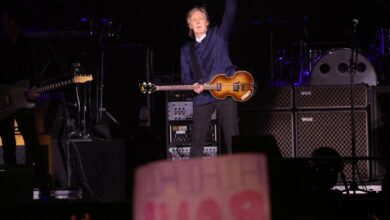‘A séance in song’: How a new album fulfils one of Eva Cassidy’s musical dreams

In 1992, four years before the death of a then-unknown singer named Eva Cassidy, and eight before she would achieve posthumous, worldwide fame, she had a dream goal for her career. “Eva had a fantasy of one day having a full orchestra back her up,” says Chris Biondo, the singer’s original arranger and bandmate. “To her, that was the greatest place you could be musically.”
In fact, she and Chris had a specific role model for her fantasy project: Natalie Cole’s album Unforgettable, a collection of standards that appeared the previous year which, thanks to the marvels of studio sorcery, created a duet between Natalie and her late father, Nat King Cole, on the title song. For Cassidy, such a project would have been impossible to finance at the time, nearly a decade before she would have two UK number one albums, a number one single with “What a Wonderful World” and a cover of Sting’s “Fields of Gold” that would stream 68 million times on Spotify.
Fast-forward to 2023 – more than 25 years after Cassidy’s death from skin cancer at the age of 33 – and her dream has finally come true. In fact, the particular way it has come true bears an uncanny resemblance to Cole’s classic recording. Much like Unforgettable, the “new” Eva Cassidy album, I Can Only Be Me, represents a kind of séance in song in which the late singer’s original vocals have been matched to the London Symphony Orchestra via rich new arrangements written by composer Christopher Willis. In order to make the new recordings truly distinct, however, Willis didn’t simply plop orchestrations on top of the classic Cassidy recordings listeners have come to love, like her diaphanous readings of Christine McVie’s “Songbird” or Cyndi Lauper’s “Time After Time”. Instead, Willis and a wide team of supporters made complex use of modern technology, with some assistance from AI, to sift out and scrub clean Cassidy’s original vocals before working them into fresh symphonic arrangements. The result puts her vintage vocals into settings that wholly redefine the scope and meaning of the song.
“This was not an easy process,” says Bill Straw, whose record label, Blix Street, engineered Cassidy’s surprise breakthrough back in 1998. “I was very mindful of the fact that it would be very easy to screw things up.”
“You’re listening very closely to her vocal and trying to do the right thing by her,” says arranger Willis of his process, which, essentially, amounted to working with a ghost. “Then, every once in a while, you’re reminded of the fact that she’s not going to walk through that door and give me notes.”
It wasn’t a new problem for anyone charged with advancing Cassidy’s legacy. When Straw first signed a deal with the singer’s estate to release her music shortly after her death, he says, “friends asked me, ‘how are you going to work with a singer who’s not available to go out and perform?’” I said, ‘it will be fine. I think we have an instant legend here.’”
Remarkably, barely anyone agreed with him at the time. Not a single major record company comprehended Cassidy’s full talent or potential while she was alive. More, she faced an internal battle. While Cassidy believed deeply in her own talent, she had little faith that others would appreciate her subtle sound and modest character. Biondo, who was the first to work with the singer, recalled a time in 1996 when he and the singer drove out to a remote factory in their native Virginia to pick up 1,000 CDs and cassettes of a live recording they had made. “When we got in the car, Eva cracked open a box and started to get very worried,” he says. “She felt she wasn’t going to be able to sell them all. I’ll never forget her comment – ‘when I’m dead and they find me, there’s going to be boxes of these in my basement’. Her expectations for the record could not have been more minimal.”
Her experience with the music industry bolstered that view. “We were knocking our heads against the wall, playing these little clubs for little or no money in front of very few people,” Biondo says. “It bothered her.”
In the early 1990s, Cassidy did have talks with half a dozen labels, but Biondo says she didn’t approach those meetings with great enthusiasm for two reasons – first, her disinterest in fame; second, her fear that the labels’ marketing people would force her to narrow the broad range of material she wanted to sing. At one point, Blue Note Records gave her a budget of $3,500 to cut six songs. She came back with songs in six different genres, a major turn off to the label. She did manage to get a new contract with Apollo Records which had the imprimatur of the storied Harlem theatre, a deal that would have allowed her to quit her day job at a plant nursery. But the label folded before she cut a single song. To rally, she and Biondo recorded the concert album, Live at Blues Alley, an indie release that had little chance of reaching many listeners.
By the time of her death, Cassidy had 127 recordings in the can, a trove Straw recognised as a precious treasure waiting to be discovered by the world. The first set they released, Songbird, caught on fast, especially in the UK where, by Christmas of 2000, exposure on the BBC of a video for Cassidy’s wondrous version of “Over the Rainbow” pushed the album to the top of the British charts.
Since then, Blix Street has issued scores of repackages, reissues and previously unheard recordings by Cassidy, selling millions of albums in the process. The new set represents the 15th such effort. While Biondo says he doesn’t think some of those packages deserved to see the light of day, he has no qualms about the new orchestral take. After listening to Willis’s re-arrangements of his original ones he says, “I’m humbled.”
The idea to put Cassidy’s vocals in a symphonic setting has been in Straw’s mind ever since he first heard her spare take on “Over the Rainbow” three decades ago. “I couldn’t help but think ‘wouldn’t it be interesting to have an orchestra do that?’” he says.
The notion to put that fantasy into motion started in 2011 with a project of duets by Michael Bolton produced by David Foster. For that album, Foster convinced Straw to let him wed a fresh Bolton vocal, as well as the work of an orchestra, to Cassidy’s vintage singing on one of her best-known covers, “Fields of Gold”. “Even Eva’s father liked that, and he’s a tough audience,” Straw says.
Emboldened by that, he hired Foster and his team to demo more Cassidy/orchestral re-dos but, eventually, he felt that their work didn’t change the original versions enough, so they parted. He found Willis through several movie scores he wrote that were released on Blix Street’s British arm. At first, Willis approached the project tentatively. “This was just an experiment,” he says. “It wasn’t like a huge record company came to us and said, ‘this is happening. Make it work!’ It was more like ‘if it doesn’t work, it will just go away.’”
Crucial to making it work was new technology first employed by Peter Jackson to reconfigure the sound recorded for the 1970 Beatles documentary Let It Be, for his revelatory Disney+ series Get Back in 2021. Part of that process involved AI, although, Willis says, “that only gets you so far. You’re telling the machine’s algorithm as much as possible about what you want it to do. But sometimes it mangles things.”
Not a single major record company comprehended Eva Cassidy’s full talent or potential while she was alive
The audio-forensic process wasn’t just painstaking, but multifold. One team worked on Cassidy’s vocals, another on the original recordings’ instruments, most of which had been recorded either in Biondo’s sub-budget studio or in live settings rife with clinking glasses and audience chatter. Biondo imagines some of what they had to work with “must have been a nightmare. I remember recording [the title track] ‘I Can Only Be Me’, in a little room right next to a furnace that was roaring because it was winter and we were freezing,” he says. “I’m sure they were cussing me out having to deal with that!”
In fact, the tech team wound up stripping out most of the original instruments to allow Willis a fresh canvas on which to paint his lush sounds. The result adds evocative aural colours that interact intimately with Cassidy’s vocals. For the seaside song “Waly Waly”, Willis thought “of Vaughan Williams and Debussy and Elgar, composers who were concerned with the coast. The sounds around Eva suggest seagulls and waves,” he says.
For the new version of Buffy Sainte-Marie’s haunting ode “Tall Trees in Georgia”, they eliminated Cassidy’s original acoustic guitar accompaniment, a revelation to the song’s author. “I was always flattered that Eva performed ‘Tall Trees’ exactly as my own version, with that feathery finger pad strumming and the slow telling of the story,” says Sainte-Marie. But “to hear Eva with the LSO is also wonderful! I love the album!”
Regarding Cassidy as an artist, Sainte-Marie says, “she sings like a songwriter. It’s as if the song is happening in her own life.”
Chris Biondo: ‘We were knocking our heads against the wall, playing these little clubs for little or no money in front of very few people’
She sings like a songwriter. It’s as if the song is happening in her own life





